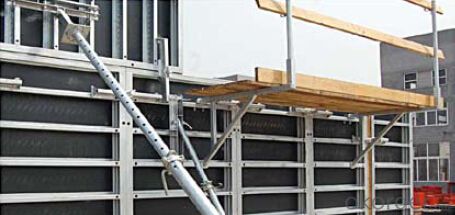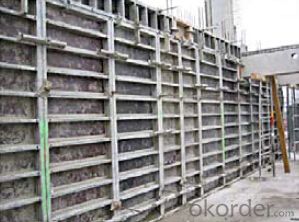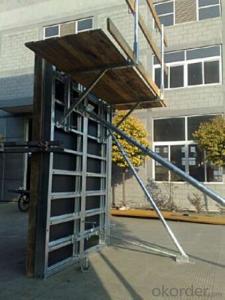Steel-frame Formwork and scaffolding system platform
- Loading Port:
- Tianjin
- Payment Terms:
- TT OR LC
- Min Order Qty:
- 50 m²
- Supply Capability:
- 1000 m²/month
OKorder Service Pledge
OKorder Financial Service
You Might Also Like
Steel-frame Formwork SF-140
Characteristics:
◆ Few parts for fast forming.
◆ Max. Concrete pressure: 80KN/m2.
◆ Hot-dip galvanized steel frame.
◆ The thickness of plywood is 18mm & the panel is 14cm.
◆ Compatibility with Hunnebeck Manto system due to similar edge profile.
System Details & Application:
◆ Neat joint and fast assembling with aligning panel clamp.
◆ Flexible panel arrangement and height extension.
◆ The selection of panels.
◆ Kinds of panel connectors.
◆ Corner clamp application.
◆ Length adjustment application.
◆ Height adjustment & aligning strut.
◆ Walkway bracket & platform.




- Q:Can steel formwork be used for both small-scale and large-scale construction projects?
- Yes, steel formwork can be used for both small-scale and large-scale construction projects. Its strength and durability make it suitable for various types of projects, regardless of their size. Additionally, steel formwork offers flexibility and can be easily customized to meet the specific requirements of different construction projects, making it a versatile choice for both small and large-scale construction.
- Q:Those who have these drawings, can send a copy to me, online, etc.
- The design of the steel formwork is 1.5 meters long or the length of 2 meters, so it can save the cost and improve the work efficiency
- Q:Can steel formwork be used for both above-grade and below-grade walls?
- Yes, steel formwork can be used for both above-grade and below-grade walls. Steel formwork is highly versatile and can be used in various construction applications, including both above-grade and below-grade walls. Its strength and durability make it suitable for withstanding the pressure and weight of the concrete used in these walls. Additionally, steel formwork can be easily assembled and disassembled, allowing for efficient construction processes for both types of walls. Whether it is for basement walls or exterior walls above ground, steel formwork can provide the necessary support and shape for the concrete to be poured, resulting in strong and long-lasting structures.
- Q:Are there any specific considerations for using steel formwork in earthquake-prone areas?
- Yes, there are specific considerations for using steel formwork in earthquake-prone areas. Steel formwork offers several advantages such as strength, durability, and reusability. However, it is crucial to ensure that the steel formwork is designed and constructed to withstand the seismic forces generated during an earthquake. The formwork system should comply with local building codes and regulations related to seismic design. It is also important to consider factors like steel quality, connection details, bracing systems, and anchorage methods to enhance the formwork's resistance to seismic loads. Additionally, regular inspections and maintenance of the steel formwork are necessary to ensure its integrity and effectiveness in earthquake-prone areas.
- Q:Is steel formwork more expensive than other types of formwork?
- The cost of steel formwork depends on various factors such as the size and complexity of the project, availability of materials, labor costs, and market conditions. Generally speaking, steel formwork tends to be more expensive than other types of formwork such as wood or aluminum. Steel formwork offers several advantages over other types of formwork, such as high durability, reusability, and the ability to support heavy loads. However, these benefits come at a higher price. Steel formwork requires a higher initial investment due to the cost of materials and the need for skilled labor for fabrication and installation. On the other hand, wood or aluminum formwork may be less expensive initially, but they may not be as durable or have the same load-bearing capacity as steel formwork. They might require frequent repairs or replacements, which can add to the overall cost in the long run. Ultimately, the choice of formwork material depends on the specific requirements of the project, budget constraints, and the expected number of uses. While steel formwork may be more expensive upfront, it often provides a better return on investment due to its durability and reusability.
- Q:Can steel formwork be used for industrial construction projects?
- Yes, steel formwork can be used for industrial construction projects. Steel formwork offers several advantages such as durability, strength, and reusability, making it suitable for heavy-duty applications in industrial construction. It provides a stable and rigid structure to support concrete during the casting process, ensuring accurate and high-quality results. Additionally, steel formwork can withstand harsh weather conditions and repetitive use, making it ideal for industrial projects that require long-term and reliable formwork systems.
- Q:What are the different material handling requirements for steel formwork?
- Steel formwork offers numerous advantages in construction projects, such as its durability, reusability, and ability to withstand high pressure and loads. However, it is important to consider specific material handling requirements associated with steel formwork. Firstly, when handling and transporting steel formwork panels, it is crucial to use suitable lifting equipment like cranes or forklifts. This ensures that the load is evenly distributed and reduces the risk of dropping or damaging the panels during transportation. Secondly, proper storage is essential to prevent rust and corrosion. The panels should be stored in a dry and well-ventilated area. Additionally, they should be stacked evenly to avoid deformation. It is important to stack them in a way that allows easy access to individual panels without causing damage to others. Regular cleaning and maintenance are necessary to ensure the longevity and reusability of steel formwork. After each use, the formwork should be cleaned to remove any concrete residue, dirt, or debris. Additionally, it is important to inspect the formwork for any signs of damage, such as cracks or bends, and repair or replace them as needed. Skilled workers are required for the proper assembly and disassembly of steel formwork. The panels need to be accurately aligned and securely connected to form a watertight structure. During disassembly, care should be taken to avoid damaging the panels, ensuring they can be reused in the future. To enhance the durability and lifespan of steel formwork, surface protection measures should be taken. This includes applying anti-corrosion coatings or paint to prevent rust and corrosion. Regular inspections should be conducted to identify any signs of damage or deterioration on the surface, and necessary actions should be taken to maintain the integrity of the formwork. In conclusion, adhering to the material handling requirements for steel formwork, such as proper handling and transportation methods, appropriate storage and stacking, regular cleaning and maintenance, skilled assembly and disassembly, and surface protection measures, is essential for optimal performance and longevity in construction projects.
- Q:What are the common problems encountered with steel formwork?
- Some common problems encountered with steel formwork include rusting or corrosion, damage due to mishandling or improper storage, difficulty in handling and assembling due to its heavy weight, and potential for warping or bending under pressure.
- Q:How does steel formwork affect the schedule of a construction project?
- The schedule of a construction project can be greatly impacted by steel formwork. The durability and reusability of steel formwork are one of its main advantages. Unlike traditional wood formwork, steel formwork can be used multiple times, resulting in faster construction cycles. This means that the formwork can be easily taken apart and put back together at different parts of the project, allowing for simultaneous construction activities and ultimately reducing the overall construction time. Furthermore, steel formwork provides better control over dimensions and accuracy, ensuring that the concrete structures are built according to the specified designs. This reduces the need for rework or corrections, which can further save time and resources. Moreover, steel formwork is known for its strength and stability, allowing it to withstand the pressure exerted by the concrete during pouring and curing. This enables faster pouring and curing times, as well as the ability to achieve higher concrete strengths in a shorter period. Additionally, steel formwork systems often have integrated features such as adjustable props and support systems, which provide flexibility and efficiency during construction. These features allow for quick adjustments and modifications, resulting in faster construction progress. However, it is important to acknowledge that the installation and dismantling of steel formwork may require specialized labor and equipment, which can add some time to the project schedule. Additionally, the initial cost of steel formwork may be higher compared to traditional formwork materials. Nevertheless, the long-term benefits and time savings provided by steel formwork can outweigh these initial costs. In conclusion, steel formwork can have a significant impact on the schedule of a construction project by reducing construction cycles, improving dimensional control, enabling faster pouring and curing times, and providing flexibility and efficiency. While it may require some additional time for installation and higher initial costs, the overall time savings and benefits make steel formwork a valuable choice for construction projects.
- Q:What are the common types of connections used in steel formwork systems?
- The common types of connections used in steel formwork systems include bolted connections, welded connections, and adjustable connections.
1. Manufacturer Overview |
|
|---|---|
| Location | |
| Year Established | |
| Annual Output Value | |
| Main Markets | |
| Company Certifications | |
2. Manufacturer Certificates |
|
|---|---|
| a) Certification Name | |
| Range | |
| Reference | |
| Validity Period | |
3. Manufacturer Capability |
|
|---|---|
| a)Trade Capacity | |
| Nearest Port | |
| Export Percentage | |
| No.of Employees in Trade Department | |
| Language Spoken: | |
| b)Factory Information | |
| Factory Size: | |
| No. of Production Lines | |
| Contract Manufacturing | |
| Product Price Range | |
Send your message to us
Steel-frame Formwork and scaffolding system platform
- Loading Port:
- Tianjin
- Payment Terms:
- TT OR LC
- Min Order Qty:
- 50 m²
- Supply Capability:
- 1000 m²/month
OKorder Service Pledge
OKorder Financial Service
Similar products
New products
Hot products
Hot Searches
Related keywords






















